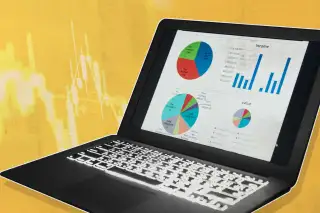Don't Skip Your Mid-Year Investment Portfolio Checkup This Year

You've probably heard the advice before: Check on your investment portfolio at the mid-year mark to make sure you're on track to achieve your goals. But this year, it's especially important.
Financial markets have put investors through a rollercoaster-like experience over the past year. In 2021, the stock market kept hitting record highs, and buying risky options like cryptocurrency and SPACs paid off. The outlook is a lot different today. The S&P 500, an index commonly used as a benchmark for the overall performance of the stock market, fell into a bear market in June, meaning that it fell at least 20% from the most recent peak. Pandemic stock winners like Peloton and Zoom have watched their prices tumble more than 70% and 40% respectively this year, and 10 out of the 11 S&P 500 sectors have tanked in 2022.
For new investors and seasoned pros alike, the volatility can be scary. Luckily, experts say that revisiting your portfolio regularly — like once a quarter or every six months — can help immensely with setting you up for success in the long term. Now that we've reached the halfway point of 2022, it's time to actually take that step.
"It's been a year like we’re not familiar with in recent history,” says Lauren Wybar, senior wealth advisor at Vanguard. "It’s unusual compared to what we’re used to."
Here's what you need to pay attention to when doing a mid-year portfolio checkup.
Tax advantages
If you make a few smart tax moves this year when the market is down, you may be able to save on your tax bill come April.
"Taxes are really the largest expense that a lot of people incur," says Charlene Wehring, a certified public accountant and founder of Wehring Wealth Management. "Every decision you make in your financial plan has some kind of tax consequence."
Wehring recommends looking into whether you have losses in your portfolio that could be offset with tax-loss harvesting. Essentially, tax-loss harvesting allows you to sell an asset when its price is lower than the price you bought it for and use that loss to offset gains elsewhere in your portfolio. This can be a useful move because whenever you sell an asset like stocks or crypto you need to pay taxes on the profit. The IRS lets taxpayers count up to $3,000 of ordinary income of losses towards their gains and carry over losses forward to future years if needed.
If you decide to tax-loss harvest, keep in mind there are restrictions. You can't sell an investment when its price is down and immediately buy it — or one that is “substantially identical" — back right away. Make sure that the benefits outweigh the risks for your specific financial situation.
Another move to consider during your mid-year portfolio check up this year is a Roth individual retirement account (IRA) conversion.
A traditional IRA is funded with pre-tax dollars, and you pay taxes on your withdrawals down the line. But a Roth IRA is funded with after-tax dollars, so when you take out your money after age 59 1/2, you don't have to pay taxes on those withdrawals. If you want to benefit from taking your money out tax-free down the line, you may consider converting your IRA into a Roth IRA — and since you have to pay taxes on the money in that account, it may be best to do so now, when your balance is likely lower than it has been and will be in the future.
"They're able to convert with a lesser consequence," Wehring says. "As the market goes back up, your Roth will recover tax-free."
Asset allocation
A mid-year checkup is also the perfect opportunity to verify that your investment portfolio is still in line with your goals, risk tolerance and time horizon. A volatile market is an especially good time to do that because you can reassess how comfortable you are with your portfolio in the face of market turbulence.
Did the drop in stock prices cause you to panic about having enough money for an upcoming expense, like buying a home? If yes, that might be a sign that it's time to take a bit of risk off the table and confirm you have enough cash available at your mid-year check-in to continue weathering this storm.
For the most part, an investor ought to have a predetermined long-term investment risk tolerance and objective that shouldn’t change just because the markets move, says Thomas Martin, senior portfolio manager at Globalt Investments. But investors do need to regularly rebalance their portfolios to ensure they're aligned with those original goals.
Rebalancing refers to buying or selling assets so your portfolio allocations are in line with your investment plan. In doing so, investors can ensure that they maintain a diversified portfolio with a mix of stocks, bonds and cash that is appropriate for them. A diversified portfolio can provide protection because when one area of your portfolio plummets, another different asset may be able to remain steady. For example, in March of 2020 stocks tanked while Treasury bonds held their ground.
Of course, sometimes financial markets fall together — this year even the classic 60%-stock, 40%-bond portfolio has gotten clobbered. But still, having a diversified portfolio means that, when markets recover, your portfolio will include a variety of assets that regain their value and won't be concentrated in one space.
In short, it's smart to check in, especially when markets are volatile like they are now. But investors shouldn't make knee-jerk decisions based on price moves.
“It’s really about them and their needs and not all the noise going on in the market," Martin says.
More from Money:
'Trying Not to Freak Out': How New Investors Are Coping With Their First Bear Market
The Stock Market Downturn Isn't as Bad as You Think (Probably)